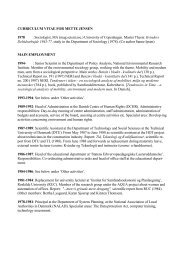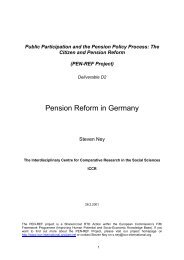The Housing Dimension of Welfare Reform - the ICCR
The Housing Dimension of Welfare Reform - the ICCR
The Housing Dimension of Welfare Reform - the ICCR
Create successful ePaper yourself
Turn your PDF publications into a flip-book with our unique Google optimized e-Paper software.
(b) When evaluating <strong>the</strong> ‘success’ <strong>of</strong> social programmes targeting<br />
persons or families who are excluded or marginalized out <strong>of</strong> a<br />
combination <strong>of</strong> structural and personal factors, it is important<br />
to recall that ‘success’ is a relative concept and term, just like<br />
re-integration (following a prolonged period <strong>of</strong> social<br />
exclusion) is a long-term process involving several steps. <strong>The</strong><br />
effect <strong>of</strong> specific forms <strong>of</strong> support, like housing, must thus be<br />
assessed in relation to o<strong>the</strong>rs forms <strong>of</strong> support, especially with<br />
regard to work (and <strong>the</strong> re-integration into <strong>the</strong> labour market),<br />
health and social contacts.<br />
In <strong>the</strong> section that follows we formalise <strong>the</strong> above approach for <strong>the</strong><br />
purpose <strong>of</strong> transferability in o<strong>the</strong>r fields <strong>of</strong> social policy following <strong>the</strong><br />
open method <strong>of</strong> coordination.<br />
4.1.3 Towards a standardisation and transferability <strong>of</strong> <strong>the</strong> EUROHOME-<br />
IMPACT method<br />
As we saw above, <strong>the</strong> open-method <strong>of</strong> coordination aims to provide a<br />
framework for promoting intelligent ‘policy mimicking’ towards a<br />
European social policy agenda. This approach has been tried out in <strong>the</strong><br />
field <strong>of</strong> fighting income poverty (<strong>the</strong> so-called National Action Plans for<br />
Social Inclusion) as well as in <strong>the</strong> field <strong>of</strong> dealing with unemployment<br />
(so-called National Action Plans for Employment). Both ‘national plan’<br />
procedures have involved intensive information exchange among<br />
Member States through <strong>the</strong> specification <strong>of</strong> common criteria and <strong>the</strong>ir<br />
regular monitoring.<br />
<strong>The</strong> EUROHOME-IMPACT project provides <strong>the</strong> basis for extending <strong>the</strong><br />
basis <strong>of</strong> such comparisons and information exchanges. How this should<br />
be done is described below.<br />
Identify <strong>the</strong> target area and specify its scope<br />
<strong>The</strong> first and <strong>of</strong>ten most challenging task <strong>of</strong> evaluation exercises is<br />
defining <strong>the</strong> target area and its scope. How a specific problem is dealt<br />
with is, <strong>of</strong> course, influenced by how it is defined in <strong>the</strong> first place.<br />
However, <strong>the</strong> challenge is only in part one <strong>of</strong> social construction but,<br />
primarily, an analytical one.<br />
Relevant in this respect is how wide or narrow <strong>the</strong> field <strong>of</strong> study,<br />
monitoring or intervention is defined. <strong>The</strong> evaluation or benchmarking<br />
exercise will follow different procedures depending on whe<strong>the</strong>r, say, <strong>the</strong><br />
target area is defined as ‘housing integration’ or as ‘fighting<br />
homelessness’. In <strong>the</strong> former case, <strong>the</strong> target area is defined ra<strong>the</strong>r<br />
EUROHOME-IMPACT FINAL REPORT 63









